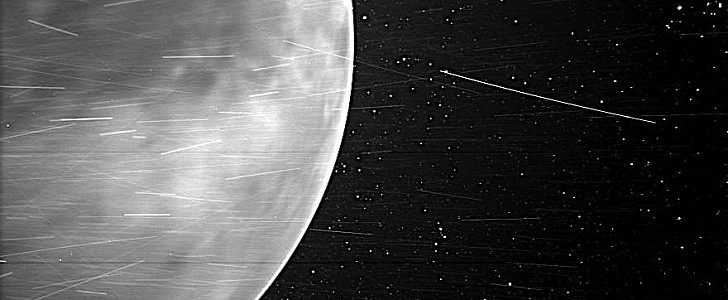
Photo: NASA/Johns Hopkins APL/Naval Research Laboratory/Guillermo Stenborg and Brendan Gallagher
In August 2018, a special mission to study the Sun took off from Space Launch Complex-37 at Cape Canaveral Air Force Station. It is called Parker Solar Probe, and it is also the fastest human-made object, capable of reaching a speed of 430,000 miles per hour (692,000 kph).
Parker’s mission is to perform flybys of the Sun at a proximity never achieved before (as close as 3.8 million miles/6.1 million km), allowing scientists here on Earth to learn how to better predict space weather events. To achieve this proximity and speed, the probe will have to repeatedly circle the Sun, using planet Venus' gravity as a rudder of sorts to change course.
Over the 7-year duration of the mission, Parker will make seven Venus flybys, and 24 total passes by the Sun. At the end of last month, it just nailed its fourth Venus encounter, zooming past the planet at speeds of 54,000 mph (86,900 kph). It did so while at a distance of just 1,482 miles (2,385 km) off the planet’s surface, reason enough for the team running Parker to celebrate. They did so by releasing an incredible image of Venus captured by the probe from 7,693 miles (12.380 km), during a similar maneuver performed in the summer of last year - you can see it as the main photo of this piece.
This February's Venus run put Parker on course for the eighth and ninth close passes by the Sun, scheduled to take place at the end of April and beginning of August, respectively. The probe is closing the distance to the Sun each time it passes by, this time shedding 1.9 million miles (3 million km) from the previous record, and coming within 6.5 million miles (10.4 million km) from the solar surface.
The people behind the probe are the scientists from the Johns Hopkins Applied Physics Laboratory, and the probe is part of NASA’s Living with a Star Program (LWS), meant to explore aspects of the Sun-Earth system that directly affect "life and society."
Over the 7-year duration of the mission, Parker will make seven Venus flybys, and 24 total passes by the Sun. At the end of last month, it just nailed its fourth Venus encounter, zooming past the planet at speeds of 54,000 mph (86,900 kph). It did so while at a distance of just 1,482 miles (2,385 km) off the planet’s surface, reason enough for the team running Parker to celebrate. They did so by releasing an incredible image of Venus captured by the probe from 7,693 miles (12.380 km), during a similar maneuver performed in the summer of last year - you can see it as the main photo of this piece.
This February's Venus run put Parker on course for the eighth and ninth close passes by the Sun, scheduled to take place at the end of April and beginning of August, respectively. The probe is closing the distance to the Sun each time it passes by, this time shedding 1.9 million miles (3 million km) from the previous record, and coming within 6.5 million miles (10.4 million km) from the solar surface.
The people behind the probe are the scientists from the Johns Hopkins Applied Physics Laboratory, and the probe is part of NASA’s Living with a Star Program (LWS), meant to explore aspects of the Sun-Earth system that directly affect "life and society."
